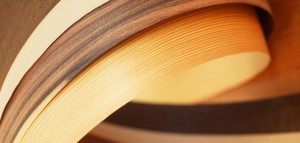VENEER OR RECON VENEER

Veneer or Recon Veneer
Wood veneers are attractive and rightfully popular materials used for interiors of homes, office and other business establishments, aircrafts and more, as well as the enhancement of everything from furniture pieces to musical instruments. The are generally classified into two distinct kinds : Natural Wood Veneer & Recon Wood Veneer
Natural Wood Veneer
Natural veneers are sliced from logs, and each logs are influenced by an individual tree’s reaction to its soil composition geographic location and other growing conditions throughout this duration of its growth. The intrinsic patterns and markings in natural veneers aren’t altered or enhanced in any way, making each natural veneer from a tree an individual work of art.
Recon Veneer
Recon veneers is short for reconstituted wood also know as recomposed, man-made or manufactured veneers.
So what is recon veneer?
Recon wood veneers are made with actual wood from fast growing trees in managed forests. Recon veneers are a renewable product and also it is an environmentally friendly alternative to some of the rarer and extremely expensive veneers.
How is it made?
Our NAV & EVN are made through these 5 general steps

Rotary Cut Veneer
The timber logs are rotary cut to produce the veneer. We do this by rotating the log around its axis. A knife is positioned against the log to peel off a thin layer of wood. During this process we also cut the correct width of the wood.

Dyeing
Dyeing is a very important part of the process when producing reconstituted veneer.
The veneer strips are submerged in a bath of water at a specific temperature and with the required dye concentrate.
The dyeing process uses 100% water-based dyes. No heavy metals or other toxic substances are used
NAV and EVN reconstituted veneer strips are dyed multiple times to ensure colour-fastness.
Both NAV and EVN guarantee color-fastness up to 5 years

Creating The Pattern
The dyed veneer strips are mixed to produce the desired reconstituted wood species or design. Here, the eye for detail and beauty work to complement the deep color-fastness of our veneers

Pressing the logs
The veneer block is now placed in a press. The press plates can be flat or have a certain shape. This also has an impact on the appearance.
Reconstructed Veneers Advantages
- Stable wood grain
- Stable color
- Easy to use & Renovation
- Free from splits, knots, holes or discoloration
- Better suited for modern furniture and manufacturing processes
- Low formaldehyde
- Color guaranteed
- FSC certificate provided
- Non-toxic dyes
- Supplied from Australia

